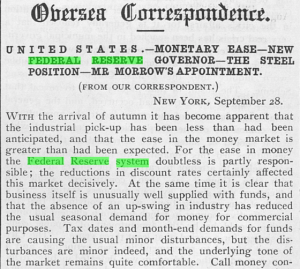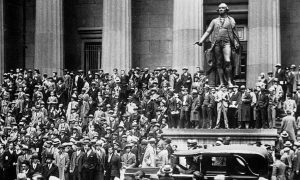“Monetary Ease – New Federal Reserve Governor”, Overseas Correspondence from The Economist, September 28, 1927

This excerpt from The Economist was published on September 28, 1927 in the London company’s New York correspondent. The source surveys the recent actions of the Federal Reserve and states that the monetary easing enacted by the system was responsible for the over supplementation of money in the market, resulting in an uncharacteristically weak demand for funds. The system was created in 1913 and suffered growing pains that adversely affected the economy, insofar that many economists cite the Federal Reserve’s constant shifting of interest rates as a primary factor that led to the Great Depression. Additionally, the newspaper admits minor disturbances to the economy but quells fears of economic collapse by arguing that the market remained in a strong position. This incorrect analysis of the state of economy in regards to future success proved to be fatal for many individuals; the poor adjustments of interest rates by the Federal Reserve, along with over-saturation of the money market, drove the United States down the path towards the Great Depression, though many individuals did not anticipate such an event until it was too late.
A Crowd of Speculators Gather in front of the New York Stock Exchange on Black Thursday, 24 October 1929.

This photograph from Getty Images was taken on October 24, 1929, one of the most infamous days in United States and world history. Hundreds of spectators congregated on the steps of Federal Hall outside the New York Stock Exchange with the goal of understanding the reasoning behind the largest single-day stock market crash in history. Under the watchful eye of a seemingly innocuous statue of George Washington, one of our nation’s Founding Fathers, each individual was not immune to the damage done by the markets. Dubbed “Black Thursday,” the stock market declined by over eleven percent, and subsequent crashes similar in magnitude continued to rock the national and global economic landscapes, sending the United States tumbling into the greatest recession it had ever experienced. Though a surprise to many, warning signs were evident in the lead up to this tragic event. The Federal Reserve neglected to raise interest rates to address overinvestment and a national years-long spending spree, which created a bubble which just so happened to pop on the last Tuesday in October of 1929.
Excerpts from FDR’s Radio Address to the Nation Unveiling the Second New Deal (October 31, 1936)
“For twelve years this Nation was afflicted with hear-nothing, see-nothing, do-nothing Government. The Nation looked to Government, but the Government looked away. Nin mocking years with the golden calf and three long years of the scourge! Nine crazy years at the ticker and three long years in the breadline! Nine made years of mirage and three long years of despair. Powerful influences strive today to restore that kind of government with its doctrine that that (sic) Government is best which is most indifferent.”
Delivered to the general public via radio on October 31, 1936, President Franklin Delano Roosevelt introduces the Second New Deal during a campaign stop at Madison Square Garden in New York City. Given the night before the citizens of America went to the polls to elect their next president, President Roosevelt employs the use pathos to appeal to voters. He argues that having attempted to rescue the United States’ economy through his first New Deal, the only way to truly recover is continue down the path of serious government intervention. Having created many new institutions and passed many acts in his first years in office, such as the formation of the Civilian Conservation Corp and passing the Social Security Act, FDR knew that he could offer more to the American people, and thus, to experience the full effect of his programs, the people of the nation should elect him to a second term as president.
